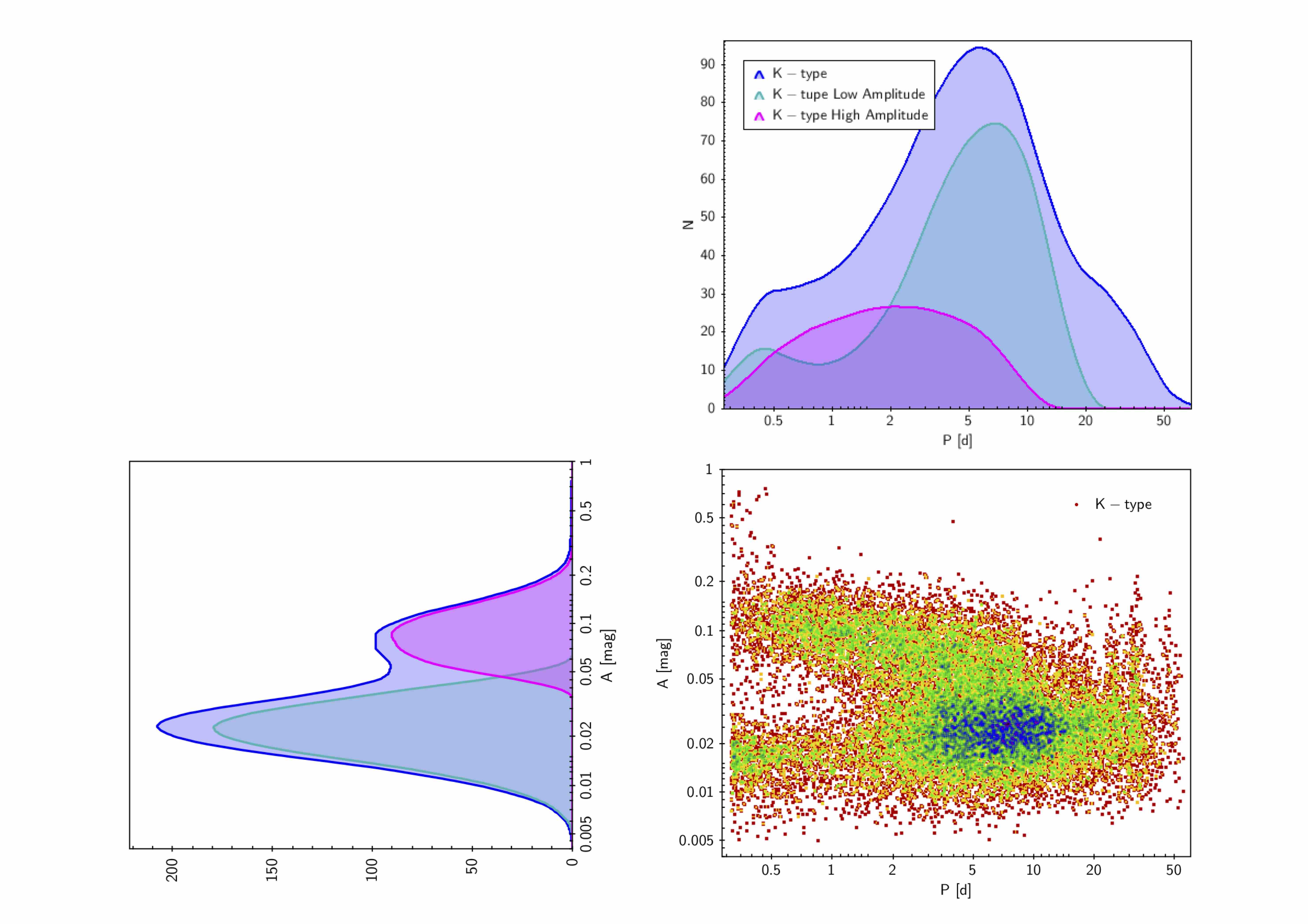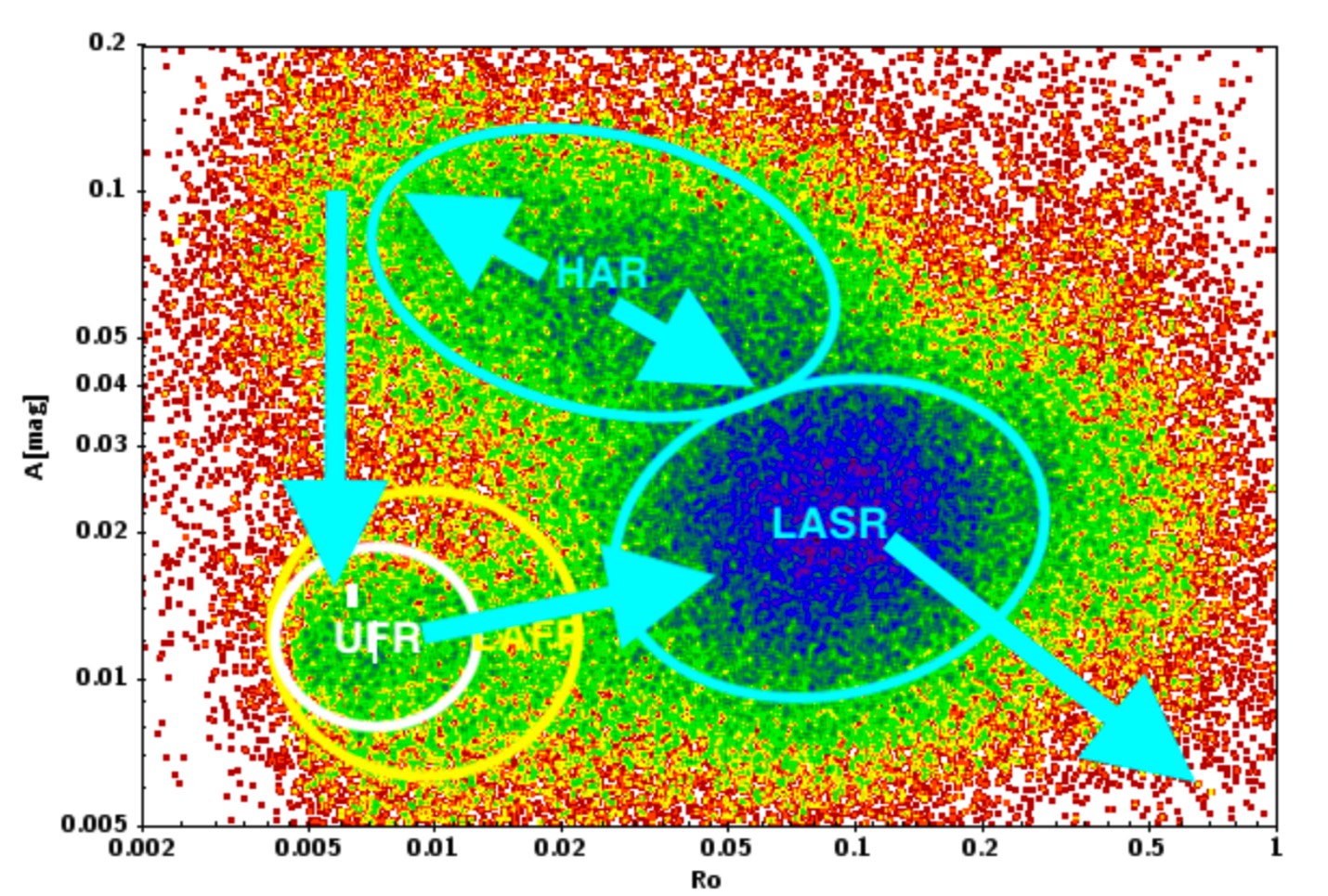IoW_20190524 - Gaia
Image of the Week |
Evidence of new magnetic transitions in late-type stars with Gaia DR2 |
|
|
|
Figure 1: This diagram shows the amplitude-period density diagram of rotational modulation variables in Gaia DR2 with a projection in rotation period P (a) and a projection in rotational modulation amplitude A (b). It can be clearly seen in the projection in rotation period P (a) that there is a clustering of low-amplitude K-type stars visible for periods around 0.4 days and another clustering for low-amplitude K-type stars for periods around 5 to 10 days, thus showing a multimodality in this diagram. Image credit: A.C. Lanzafame et al. (2019, ApJ) |
|
About 26% of the variable sources published in the Gaia Data Release 2 are rotational modulation variable candidates. These variable stars show a variation in their luminosity due to their rotation and due to surface inhomogenieties, like for example spots. The flux modulation induced by these surface inhomogenieties visible in these variables can be used to infer the stellar rotation period. The presence of a multimodality in the rotational modulation amplitude versus rotation period diagram was outlined in the A&A Gaia data processing paper "Gaia Data Release 2: Rotational modulation in late-type dwarfs". In the paper "Evidence of New Magnetic Transitions in Late-Type Dwarfs from Gaia DR2" by A. Lanzafame et al. (2019) that was recently published in ApJ, this multimodality has been put into context by cross-matching with stars of known type and compared with data from the Kepler mission, a space mission dedicated to find transiting exoplanets. It outlines the importance of the original discovery and proposes a new scenario for the magneto-rotational evolution of stars from the Pre-Main Sequence to the late Main Sequence. A scenario for the low-mass stellar rotational evolution after Gaia DR2. Three major clusterings are seen which correspond to high-amplitude rotator (HAR), low-amplitude fast-rotator (LAFR), and low-amplitude slow-rotator (LASR) branches. The latter clustering, the low-amplitude fast-rotator branch, contains a group of ultra-fast rotators (UFR). Image credit: A.C.Lanzafame et al. (2019, ApJ)
As can be seen in the above figure, the amplitude-period density diagram of rotational modulation variables in Gaia DR2 shows three major clusterings corresponding to high-amplitude rotator, low-amplitude fast-rotator, and low-amplitude slow-rotator branches. The low-amplitude fast-rotator branch contains a group of ultra-fast rotators. This diagram suggests a new scenario for the magneto-rotational evolution of stars that develop a radiative core and a convective envelope on the main-sequence. Young stars are located in the high-amplitude branch and spin-up while contracting towards the zero-age main-sequence. Once they ingnite the H-burning in the radiative core, they start to spin-down and eventually undergo a rapid transition to the low-amplitude slow-rotator branch. This new scenario thus suggests that the stars undergo a magnetic transition in their early evolution on the main sequence that leads to a sudden change of their surface appearance. The evidence points, in fact, to a sudden change of stellar surface inhomogenieties (like spots) that reduce dramatically the amplitude of the light modulation in very short timescales. However, if the star spins-up so much to approach the breakup velocity, i.e. when the centrifugal force at the equator becomes comparable to the gravity force, the star undegoes a very rapid transition from the high-amplitude branch to the ultra-fast rotator regime. From there the star spins-down toward the low-amplitude slow-rotator branch. This latter corresponds to the unsaturated regime seen in X-rays and chromospheric activity. This is a most unexpected and dramatic change for a star spinned-up to almost breakup velocity in their contraction towards the main sequence. These stars reduce their modulation amplitude by a factor 10 in a very short timescale, leaving a clear gap in the amplitude-period diagram.
Further reading: |
|
Credits: A.C Lanzafame et al. (2019, ApJ) [Published: 24/05/2019] |
- Removed a total of (7) style text-align:center;
- Removed a total of (4) style text-align:justify;
- Removed a total of (1) border attribute.
- Removed a total of (1) cellpadding attribute.
- Removed a total of (1) cellspacing attribute.
Image of the Week Archive
- Removed a total of (1) border attribute.
- Removed a total of (1) cellpadding attribute.
- Removed a total of (1) cellspacing attribute.








































 Sign in
Sign in
 Science & Technology
Science & Technology

